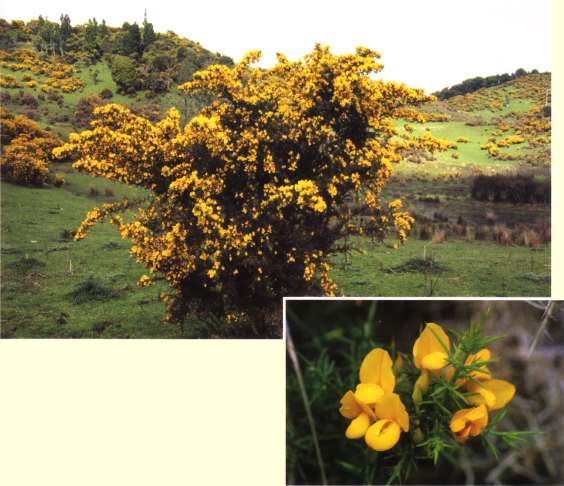|
 An
Illustrated Guide to An
Illustrated Guide to
Common Weeds
of New Zealand
Ulex
europaeus
gorse
Family
FABACEAE
Reproduced from
Common
Weeds of New Zealand
by Ian Popay, Paul Champion & Trevor James
ISBN 0 473 09760 5
by kind permission of the
New
Zealand Plant Protection Society
Publication or other use of images or descriptive
text on these pages is unauthorised unless written permission is
obtained from the authors and publisher.
Appropriate acknowledgement
of the publication Common Weeds of New Zealand must always
be given.
Available from Nationwide Book Distributors
Very spiny, woody
perennial shrub up to 2 m or more tall. Glorious yellow flowers
mostly in autumn, winter and early spring, followed by explosive
seed pods.
- Flowers
Magnificent massed display of solitary, golden-yellow pea-like
flowers, 15-20 mm in diameter. Flowers May-Nov.
- Fruit
Black pods, up to 25 mm long, with soft grey hairs. Pods split
explosively to disperse the few shiny, smooth round seeds.
- Leaves
True leaves are on the seedlings only, changing to narrow, deeply
furrowed, rigid spines 15-30 mm long, with shorter lateral spines.
- Stems
Erect or spreading, branched, deeply-furrowed, with many stiff
spines.
- Roots
Deep, branched, woody roots.
Habitat
River-beds, pasture,
scrubland, forest margins and waste land.
Distribution
Widespread throughout
NZ including Stewart, Chatham, Campbell and Auckland Islands.
Originally from western Europe to Italy.
Comments
New Zealand's worst
weed, originally introduced as a hedging plant and ornamental,
and now established on thousands of hectares of hill and less
intensively farmed country. Despite the expenditure of millions
of dollars on herbicides, discing, slashing and burning, this
weed is still a huge and expensive problem. It recovers quickly
after being burnt, but, in many areas, if left undisturbed for
long enough, it acts as a nurse crop for the regeneration of native
bush. Gorse is also a problem weed in parts of Spain, Portugal,
Chile, Ireland, coastal Oregon and southern Australia. Several
insect species have been introduced in attempts at biological
control. The gorse seed weevil (Apion ulicis) has become
established in most parts of NZ, and reduces seed production considerably,
but much seed survives. The gorse spider mite (Tetranychus
lintearius) established well in some areas, but predatory
insects reduce its effectiveness in some places. Subject to Pest
Plant Management Strategies in most regions of NZ. Details are
available from individual regional councils or unitary authorities.
Derivation
of botanical name
Ulex (Lat.)
= gorse; europaeus (Lat.) = European
Web-notes:
Weed Links
On this site
Reproduced from Common Weeds
of New Zealand:
External Links
 Weedbusters
New Zealand Weedbusters
New Zealand
- Weedbusters is a weeds awareness and education programme that aims to
protect New Zealand's environment from the increasing weed problem.
- AgPest
- A free tool to assist farmers and agricultural professionals in decision-making regarding weed and pest identification, biology, impact and management.
 New Zealand Weeds Key New Zealand Weeds Key
- An interactive identification key to the weeds of New Zealand. Developed at Landcare Research.
New
Zealand Plant Conservation Network naturalised plants
- Search for information on more than 2500 naturalised and weedy plants.
 New
Zealand Plant Protection Society New
Zealand Plant Protection Society
- Their main objective: "To pool and exchange information on the biology
of weeds, invertebrate and vertebrate pests, pathogens and beneficial organisms
and methods for modifying their effects."
-
 Massey
University Weeds Database Massey
University Weeds Database- A site providing information about New Zealand weeds and weed control.
It has a series of pages showing pictures of New Zealand weeds, notes on
identification and control. It also provides information on a university
paper entitled Controlling Weeds.
-
-
More
Plant Profiles
|







